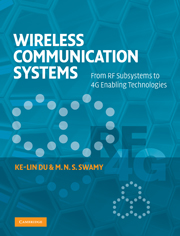Book contents
- Frontmatter
- Contents
- Preface
- Abbreviations
- 1 Introduction
- 2 An overview of wireless communications
- 3 Channel and propagation
- 4 Cellular and multiple-user systems
- 5 Diversity
- 6 Channel estimation and equalization
- 7 Modulation and detection
- 8 Spread spectrum communications
- 9 Orthogonal frequency division multiplexing
- 10 Antennas
- 11 RF and microwave subsystems
- 12 A/D and D/A conversions
- 13 Signals and signal processing
- 14 Fundamentals of information theory
- 15 Channel coding
- 16 Source coding I: speech and audio coding
- 17 Source coding II: image and video coding
- 18 Multiple antennas: smart antenna systems
- 19 Multiple antennas: MIMO systems
- 20 Ultra wideband communications
- 21 Cognitive radios
- 22 Wireless ad hoc and sensor networks
- Appendix A The Q-function
- Appendix B Wirtinger calculus
- Index
16 - Source coding I: speech and audio coding
Published online by Cambridge University Press: 05 June 2012
- Frontmatter
- Contents
- Preface
- Abbreviations
- 1 Introduction
- 2 An overview of wireless communications
- 3 Channel and propagation
- 4 Cellular and multiple-user systems
- 5 Diversity
- 6 Channel estimation and equalization
- 7 Modulation and detection
- 8 Spread spectrum communications
- 9 Orthogonal frequency division multiplexing
- 10 Antennas
- 11 RF and microwave subsystems
- 12 A/D and D/A conversions
- 13 Signals and signal processing
- 14 Fundamentals of information theory
- 15 Channel coding
- 16 Source coding I: speech and audio coding
- 17 Source coding II: image and video coding
- 18 Multiple antennas: smart antenna systems
- 19 Multiple antennas: MIMO systems
- 20 Ultra wideband communications
- 21 Cognitive radios
- 22 Wireless ad hoc and sensor networks
- Appendix A The Q-function
- Appendix B Wirtinger calculus
- Index
Summary
Introduction
Source coding or data compression is used to remove redundancy in a message so as to maximize the storage and transmission of information. In Chapter 14, we have introduced Shannon's source-coding and rate-distortion theorems. We have also introduced lossless data compression based on the source-coding theorem. In Chapters 16 and 17, we will address speech/audio and image/video coding. Lossy data compression is obtained by quantizing the analog signals, and the performance of quantization is characterized by the rate-distortion bound. Source coding is the procedure used to convert an analog or digital signal into a bitstream; both quantization and noiseless data compression may be part of source coding.
Coding for analog sources
Source coding can be either lossy or lossless. For discrete sources, a lossless coding technique such as entropy coding is used. Huffman coding is a popular entropy coding scheme. Lossless coding uses more radio spectrum. For analog sources, lossy coding techniques are usually used.
PCM is a digital representation of an analog signal. The signal magnitude, sampled regularly at uniform intervals, is quantized to a series of symbols in a digital, usually binary code. This can be performed by using A/D converters. The demodulation of PCM signals can be performed by DACs. The PCM code is the original waveform for source coding. There are three approaches to source coding.
- Type
- Chapter
- Information
- Wireless Communication SystemsFrom RF Subsystems to 4G Enabling Technologies, pp. 659 - 706Publisher: Cambridge University PressPrint publication year: 2010



